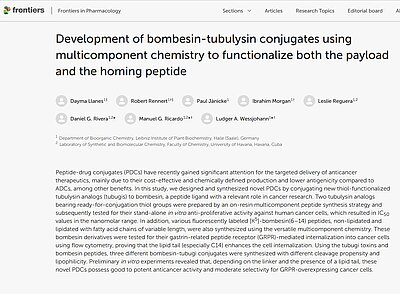Selective cancer drugs in the pipeline.
Peptide-drug conjugates (PDCs) are increasingly becoming the focus of cancer research, as they enable the targeted release of anticancer agents in tumor tissue. Like the established antibody-drug-conjugates (ADCs) these targeting proteins often have a high affinity for cancer-associated cell surface receptors, which makes them promising candidates for selective cancer therapy, especially for solid tumors. PDCs prove to be a good alternative to more complex ADCs, as their synthesis is cheaper, cleaner, more reproducible und they provide better tissue penetration. Chemists at the IPB and the University of Havana have recently developed various PDCs by conjugating novel analogs of the anti-cancer agent tubulysin with analogs of the peptide ligand bombesin.
Tubulysins are tetrapeptides with unusual residues that cause the degradation of microtubules in dividing (e.g. cancerous) cells and thus induce programmed cell death. Their exert their cytotoxic effect in very low nano- to picomolar concentrations rendering them outstanding candidates for future anticancer agents, especially PDCs. To bind the tubulysins to the bombesin peptide ligands, the Halle scientists used on-resin multicomponent peptide synthesis to produce tubulysin analogs called tubugis that are equipped with a conjugation-ready thiol group. These tubugi derivatives still show a strong antiproliferative effect in the nanomolar range when tested on cell cultures. The thiol group subsequently served as a binding site for the bombesin targeting peptide.
Bombesin is a neuropeptide that was originally isolated from the fire belly toad (Bombina bombina). Compounds of similar structure and function can be found in mammals as gastrin-releasing peptides. Bombesin derivatives play a role in all organisms in the release of the peptide hormone gastrin that leads to the production of gastric acid. The associated receptor family has considerable therapeutic potential for cancer treatment. For example, the gastrin-releasing peptide receptor, the primary bombesin receptor in humans, is increasingly produced in the expanding tissues of breast, prostate, lung and pancreatic tumors.
The binding of a bombesin-drug conjugate to the receptor could therefore ensure that anti-cancer agents selectively reach their target - the tumor tissue - and preferentially express their toxicity there and not in healthy cells. Using a multicomponent reaction, the Halle scientists produced various fluorescence-labeled bombesin derivatives equipped with fatty acid chains of different lengths. Afterwards, they tested the gastrin receptor-mediated internalization of these compounds in cancer cells. The bombesin compounds lipidated with a C14 fatty acid chain proved to be particularly capable of internalization.
The bombesin peptides were then linked to the Tubugi anticancer agents via a disulfide bridge on the previously inserted thiol group on the tubugi backbone. All resulting bombesin-tubugi conjugates were tested for their proliferation-inhibiting activities on different cancer cell lines expressing the bombesin receptor in different amounts. The results showed promising candidates with strong antiproliferative activities. The selectivity for cancer cells was good, but in the eyes of the researchers not yet sufficient to be considered for therapeutic applications. They explained this by the unspecific improvement of internalization of the PDC via the lipid tail, i.e. independent of receptor-mediated recognition. Thus, two independently beneficial modifications (lipidation and targeting peptide) together do not synergize but reduce each others effects. Further studies are therefore required to gain deeper insights into the mechanism of action of bombesin peptides as targeting molecules and the potential of this conjugate class for targeted cancer therapy. Nevertheless, bombesin derivatives, which have so far only been used successfully in the field of cancer diagnostics, should also be kept in mind for drug targeting and become the focus of further pharmaceutical developments, the research team concludes. However, what is useful distinguishing tool in molecular diagnostics should also allow selective molecular treatments eventually.


